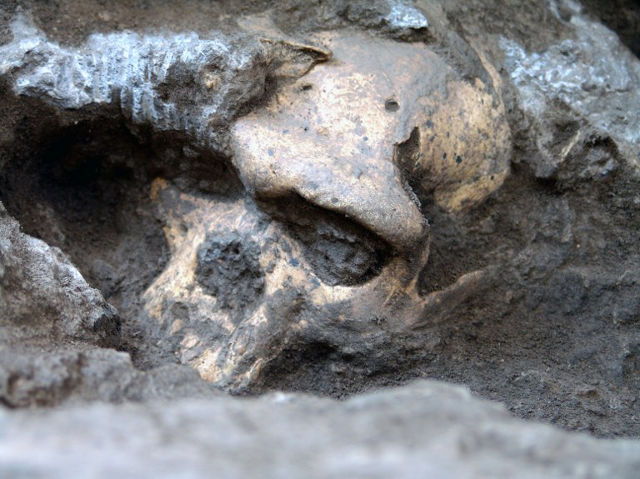SUMMARY
This is AI generated summarization, which may have errors. For context, always refer to the full article.

WASHINGTON, DC, USA – A stunningly well-preserved skull from 1.8 million years ago offers new evidence that early man was a single species with a vast array of different looks, researchers said Thursday.
With a tiny brain about a third the size of a modern human’s, protruding brows and jutting jaws like an ape, the skull was found in the remains of a medieval hilltop city in Dmanisi, Georgia, said the study in the journal Science.
It is one of five early human skulls – four of which have jaws – found so far at the site, about 100 kilometers (62 miles) from the capital Tbilisi, along with stone tools that hint at butchery and the bones of big, saber-toothed cats.
Lead researcher David Lordkipanidze, director of the Georgian National Museum, described the group as “the richest and most complete collection of indisputable early Homo remains from any one site.”
The skulls vary so much in appearance that under other circumstances, they might have been considered different species, said co-author Christoph Zollikofer of the University of Zurich.
“Yet we know that these individuals came from the same location and the same geological time, so they could, in principle, represent a single population of a single species,” he said.
The researchers compared the variation in characteristics of the skulls and found that while their jaw, brow and skull shapes were distinct, their traits were all within the range of what could be expected among members of the same species.
“The five Dmanisi individuals are conspicuously different from each other, but not more different than any five modern human individuals, or five chimpanzee individuals, from a given population,” said Zollikofer.
“We conclude that diversity within a species is the rule rather than the exception.”
Under that hypothesis, the different lineages some experts have described in Africa – such as Homo habilis and Homo rudolfensis – were all just ancient people of the species Homo erectus who looked different from each other.
It also suggests that early members of the modern man’s genus Homo, first found in Africa, soon expanded into Asia despite their small brain size.
“We are thrilled about the conclusion they came to. It backs up what we found as well,” said Milford Wolpoff, a paleoanthropologist at the University of Michigan.
Wolpoff and Adam Van Arsdale of Wellesley College published a study in the journal Evolution last year that also measured statistical variation in characteristics of early skull fossils in Georgia and East Africa, suggesting a single species and an active process of inter-breeding.
“Everyone knows today you could find your mate from a different continent and it is normal for people to marry outside their local group, outside their religion, outside their culture,” Wolpoff told AFP.
“What this really helps show is that this has been the human pattern for most of our history, at least outside of Africa,” he added.
“We don’t have races. We don’t have different subspecies. But it is normal for humans to vary, and they have varied in the past.”
But not all experts agree.
“I think that the conclusions that they draw are misguided,” said Bernard Wood, director of the hominid paleobiology doctoral program at George Washington University.
“What they have is a creature that we have not seen evidence of before,” he said, noting its small head but human-sized body.
“It could be something new and I don’t understand why they are reluctant to think it might be.”
In fact, the researchers did give it a new name, Homo erectus ergaster georgicus, in a nod to the skull as an early but novel form of Homo erectus found in Georgia.
The name also retracts the unique species status of Homo georgicus given to the jaw that was found in 2000 along with other small, primitive skulls.
The jaw lay a few yards (meters) from where Skull 5, belonging to the same owner, was later discovered in 2005.
Co-author Marcia Ponce de Leon of the University of Zurich said Skull 5 was “perfectly preserved” and “the most complete skull of an adult fossil Homo individual found to date.”
Its discovery, in such close quarters with four other individuals, offered researchers a unique opportunity to measure variations in a single population of early Homo, and “to draw new inferences on the evolutionary biology” of our ancestors, she said. – Rappler.com
Add a comment
How does this make you feel?
There are no comments yet. Add your comment to start the conversation.